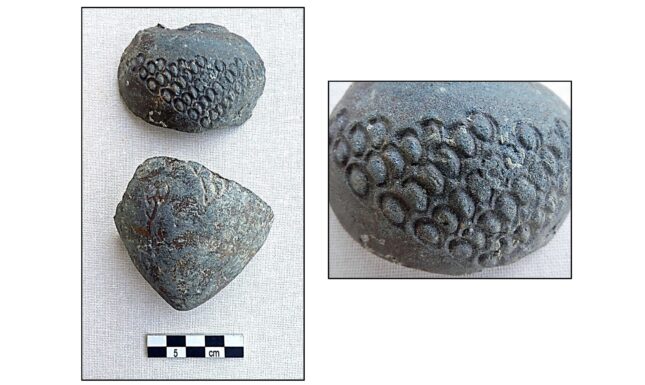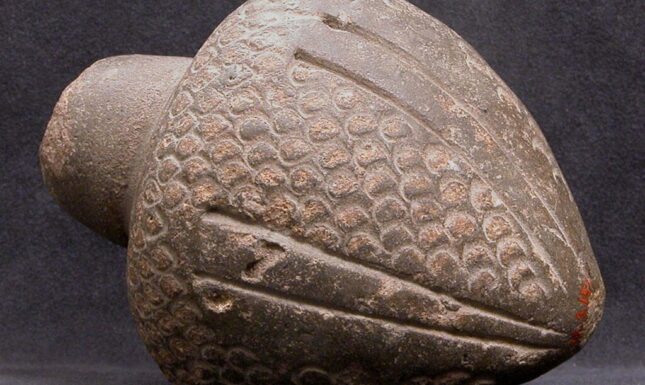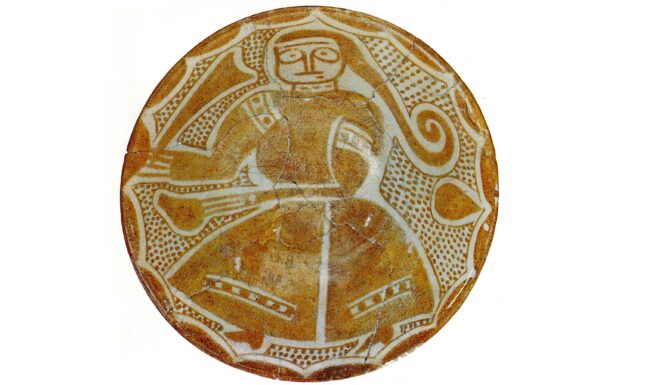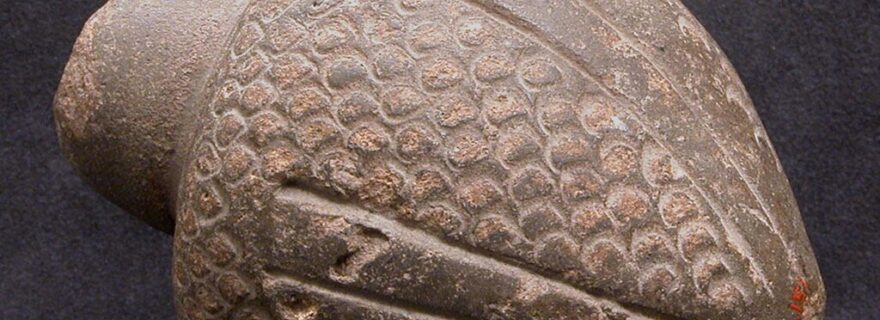Bombs, Beer, or Body Lotion? New Light on an Enigma in Islamic Archaeology
Finds of an oddly-shaped medieval vessel during excavations all over the Islamic world have puzzled archaeologists for decades. Joanita Vroom investigates the latest insights into this enigmatic small container.
While working on medieval ceramics unearthed by a large Austrian excavation project in Ephesus (western Turkey), I noticed three fragments of a ceramic sphero-conical vessel. The sherds were found in a hammam complex of the Beylık period (ca. 13th–14th centuries) that had recently been excavated. They had been unearthed in two rooms that could have functioned as shops or craftsmen’s workplaces next to the bathhouse (Figure 1).

The fragments were obviously from the enigmatic medieval vessel sometimes called ‘grenades’. These cone-shaped objects with thick cylindrical bodies, high shoulders, restricted necks, and pointed bases are known in the Islamic world from the Abbasid period (mid-8th–mid-13th centuries) to Mamluk times (13th–16th centuries). The examples found in Ephesus were notable for their ornamentation, consisting of a stamped or moulded decoration of pomegranate pits on the upper exterior. And indeed, the peculiar shape of the Ephesus pieces reminded me more of a pomegranate than of a modern hand grenade (Figure 2).

Until now, archaeologists have been quite puzzled by this vessel. In various publications, multiple functions have been suggested. One proposal was that they were used as ‘fire-blowers’ (aeolipiles or ‘balls of Aeolus’), although ‘wind-blowers’ would perhaps be a more appropriate name, as these vessels when filled with water, attached to a horizontal axis and then heated, rotated by the force of tangentially escaping steam. Another suggestion was that they were used as containers for petroleum, sulphur, naphtha, or saltpetre, and operated as flammable hand grenades or hand-thrown bombs. Furthermore, there have been suggestions that these vessels were used for the fermentation and consumption of fuqqā’, a foamy alcohol-free beer-like beverage of a gaseous nature, made of grain or rice, which was quite popular in the medieval Islamic world. Whatever their purpose, some excavated examples of these containers were even glazed and painted, or bore inscriptions (for instance wishing ‘good health’ in Arabic, which may be sincere or cynical, if the vessel was indeed used as a hand grenade).
However, ignoring the quite varied diagnostics of these vessels which floated around in the archaeological world, it was quite clear that in the Ephesian context, these small jars must have been used as a watertight container for high-valuable contents. One of their distinctive features was the tiny opening that could be easily closed. This made these vessels perfectly suited for storing and transporting precious substances.
In this perspective, the function of hand grenade or container of a popular beer-like drink does not immediately spring to mind. In the medieval Islamic world, one would rather think for example of expensive fluids like mercury, used for the making of golden jewellery, a high-quality perfumed unguent or body oil (which would make more sense given the bathing environment in which they were found) or a medical potion.
Such a fragrant ointment or healing potion may well have contained pomegranate juice or syrup for aromatising or for medical purposes (a pomegranate was described in an Islamic textual source as being ‘more a medication than a food item’). This would explain the shape as well as the decoration of the container found in Ephesus. Even the function of a medieval beer bottle can’t be ruled out entirely, as another historical source states that pomegranate juice could be added to fuqqā’ to enhance the flavour.
When taking into account all finds in the Islamic world of this enigmatic vessel, it would perhaps be wise not to restrict this container to merely one function. It seems more likely that the vessel had various (reusable) functions, depending on shape, fabric, context, and region where they were found. Based on their fabric, shape, and decoration style, the Ephesus finds undeniably came from Mamluk Egypt. A candidate for a production area may be the pottery workshop that was recently discovered at Fustat, the Arab capital of Egypt. This workshop produced an earlier type of undecorated ceramic sphero-conical vessels during the Abbasid period (beginning of the 9th century). These Egyptian ‘bottles’ seem to have been closed with a kind of cork made of pressed fibre, possibly originating from a coconut or palm tree. The shape of this earlier type of liquid container is perhaps even depicted on an Abbasid Lustreware bowl from Iraq, which shows a dancing woman holding two different vessels in her hands. One of these is an elongated goblet, obviously for drinking; the other shape could refer to the earlier type of Egyptian sphero-conical vessel (Figure 3).

Apparently, these small containers were during their long usage (from the 9th to the 14th century) suitable for long-distance transport throughout the entire Islamic world. Examples of sphero-conical vessels have been found not only at archaeological sites and collections in Turkey and Egypt, but also in Greece, Israel, Syria, Jordan, Iraq, Iran, Crimea, Russia, Azerbaijan, Uzbekistan, and Afghanistan, and in all sorts of contexts. In this wide-ranging international exchange system, the pomegranate vessels, whatever their precious content, obviously functioned as the perfect pocket bottle for many layers of Islamic society.



0 Comments